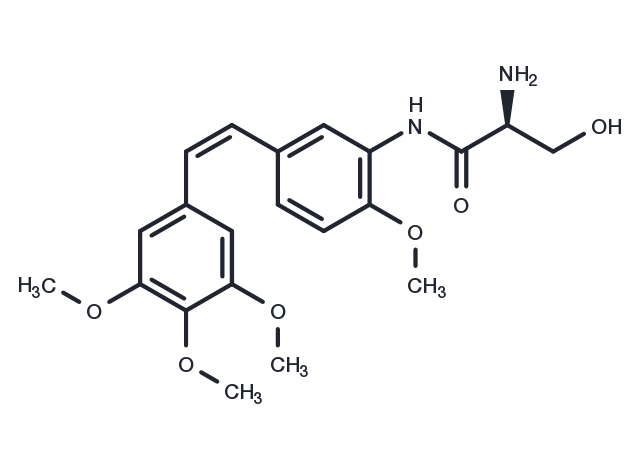Powder: -20°C for 3 years | In solvent: -80°C for 1 year


Ombrabulin is a derivative of CA-4 phosphate. It is known to show antivascular effects through selective disruption of the tubulin cytoskeleton of endothelial cells.

| Description | Ombrabulin is a derivative of CA-4 phosphate. It is known to show antivascular effects through selective disruption of the tubulin cytoskeleton of endothelial cells. |
| In vitro | Comparative analysis of the nonlinear least-squares regression of the dose-response curves for each agent alone and combination Ombrabulin /Docetaxel show a significantly lower IC50 than either agent alone (P<0.005, all cell lines). The effect of Ombrabulin on endothelial or tumor cell viability is examined using the MTT assay. The IC50 of Ombrabulin for the mouse mesenteric endothelial cells (MMEC) is 10 nM and ranges between 7 and 20 nM for the tumor cell lines (HeyA8, SKOV3ip1, and HeyA8-MDR). The cytotoxicity of Docetaxel is 2- to 4-fold greater in combination with Ombrabulin for the endothelial and tumor cells compared with Docetaxel alone[1]. |
| In vivo | The tolerability of various doses of Ombrabulin ranging from 10 to 100 mg/kg is tested given twice weekly via i.v., i.p., or s.c. routes in nude mice (n=3 per group) before performing therapy experiments. The i.p. route is well tolerated with doses up to 100 mg/kg. Starting 7 days after tumor cell injection, nude mice (n=5 per group) bearing HeyA8 ovarian cancer cells are treated with either vehicle or Ombrabulin 10, 30, 50, and 100 mg/kg twice weekly i.p. for 3 weeks. There is a 65% reduction in tumor weight in the 30 mg/kg group compared with the vehicle control group (P<0.02). The 10 mg/kg dose is not effective. The antitumor effects at doses >30 mg/kg are not significantly better; therefore, the 30 mg/kg dose is selected for subsequent therapy experiments[1]. |
| Synonyms | AVE8062, AC7700 |
| Molecular Weight | 402.44 |
| Formula | C21H26N2O6 |
| CAS No. | 181816-48-8 |
Powder: -20°C for 3 years | In solvent: -80°C for 1 year
You can also refer to dose conversion for different animals. More
bottom
Please see Inhibitor Handling Instructions for more frequently ask questions. Topics include: how to prepare stock solutions, how to store products, and cautions on cell-based assays & animal experiments, etc.
Ombrabulin 181816-48-8 Cytoskeletal Signaling Microtubule Associated AVE-8062 AVE8062 AVE 8062 AC-7700 AC7700 AC 7700 inhibitor inhibit
